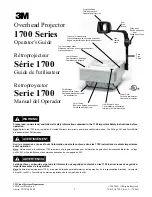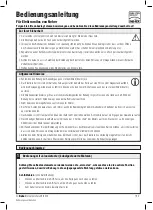
R5976255
A
TLAS
CS4 (2001-03)
8-5
Options
!
Source Number
The source number of a non-active source can be changed to any other source number. This
makes it possible to create a file for future source numbers.
!
Clamp Position
Clamping determines the black level of the signal. The clamp pulse can be related to the lead-
ing or the trailing edge of the sync pulse. Use the
ENTER
key to toggle between [leading] and
[trailing].
!
Clamp Delay
The time between the leading edge of the clamp pulse and the locked edge of the sync pulse.
Can be any value between 0 and 255. Change the value by pushing the cursor key
right
or
left
.
!
Clamp Width
The width of the clamp pulse. Can be any value between 0 and 255. Change the value by
pushing the cursor key
left
or
right
.
!
Field Polarity
The field polarity function is used for interlaced images. Both rasters of the image could be
shifted in a wrong way (double lines are visible in the image). This can be corrected by forcing
the field polarity to [
neg
] or [
pos
]. Use the
ENTER
key to toggle between [
pos
] and [
neg
].
!
Field Select: Default [
both
]
The field select is only used for interlaced images. One frame of an interlaced image contains
two fields, an even and an odd field. The choice exists to project [
both
] fields on the screen or
only the [
even
] or [
odd
] field. This can be useful for 3D projection. Use the
ENTER
key to tog-
gle between [
both
], [
even
] and [
odd
].
!
Vertical Refresh [
sync
/
async
]
The way of updating the image information on the LCD panels. Not available for PAL-NTSC-
SECAM sources. This option will be displayed in gray.
* For sources with a vertical frequency up to 60 Hz: the vertical refresh rate is the same as the
vertical frequency of the incoming source. This is a necessity to project moving images without
'motion artifacts'. For stationary images with a vertical frequency up to 60 Hz it is still possible
to use asynchronous refresh. When loading Pal, Secam, NTSC-files the synchronous mode is
default, for all other sources below 60 Hz asynchronous mode is default.
* For sources with a vertical frequency higher that 60 Hz: the vertical refresh is different than
the vertical frequency of the incoming source. Synchronous refresh cannot be used.
!
Vertical Sync Polarity [
leading
] or [
trailing
]
The vertical refresh can be synchronized with the leading sync edge or trailing sync edge. De-
fault on [
leading
].
Toggling to [
trailing
] is only necessary for special applications where the trailing edge of the
sync signal has to be taken as a reference. Use the
ENTER
key to toggle between [
leading
] or
[
trailing
]
Press
EXIT
to leave the
Edit File Option menu.
!
A
'Confirm Edit File'
menu will be displayed.
!
Press
ENTER
to confirm and to save the new settings or
EXIT
to return without saving the new
entered settings.















































